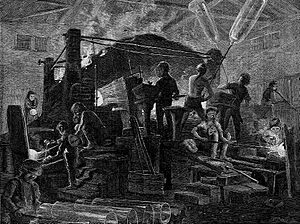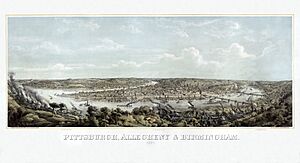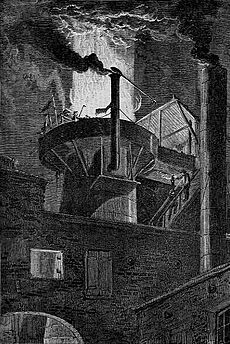History of Pittsburgh's South Side facts for kids

Pittsburgh's South Side has a long and interesting history! Back in 1763, King George III gave a large piece of land along the Monongahela River to a man named John Ormsby. This was a thank you for his help during the French and Indian War.
This land was later split into four smaller areas: South Pittsburgh, Birmingham, East Birmingham, and Ormsby. In 1872, these areas all became part of the City of Pittsburgh. Together, they formed what we know today as the South Side.
The South Side quickly became famous for making glass. The first glass factory in the area was started by James O'Hara and Isaac Craig. By the mid-1800s, South Side was the main place for glassmaking in the United States! Imagine, in 1876, there were about 76 glass factories here. Even Presidents Andrew Jackson and James Monroe ordered glass dishes for the White House from South Side companies.
These factories made all sorts of glass items, like drinking glasses, window panes, and bottles. However, by the 1920s, many glass factories moved away. This happened because of higher taxes and not enough space to grow.
Contents
Iron and Steel: Pittsburgh's Industrial Heart
Just like many other parts of Pittsburgh, the South Side became a major center for iron and steel production. Many immigrants, especially from Eastern Europe, came to work in these mills. In 1854, Benjamin Franklin Jones and James Laughlin teamed up to create a company called American Iron Workers.
Jones and Laughlin built their first blast furnace (a huge oven for melting iron) named Eliza. It was on the north side of the Monongahela River. The Hot Metal Bridge connected this furnace to the South Side. This bridge is still used by vehicles today! By 1916, their company, known as J&L, had six blast furnaces. They also had nine large open furnaces. By 1929, J&L was making 1.74 million tons of steel every year.
However, the steel industry faced tough times in the 1960s. Because of these money problems, J&L started to tear down its older buildings. By 1989, the steel industry across the country had almost disappeared. This was due to competition from other countries and changes in the market. Today, the area where the J&L steel mill once stood is now The Southside Works. It's a modern complex with shops, offices, entertainment, and homes.
Bridges: Connecting the City
Before bridges were built, the only way to cross the river was by ferry. Today, Pittsburgh is known as the "City of Bridges." Many historic bridges cross the Monongahela River into the South Side.
The Monongahela Bridge, now called the Smithfield Street Bridge, was first designed in 1818. It was built using wood and iron. During the Great Fire of Pittsburgh in 1845, this bridge was destroyed in just ten minutes! It was rebuilt in 1846 with a new design. It became a wire rope Suspension Bridge, designed by John A. Roebling.
The Liberty Bridge was built in 1928. It was designed by George S. Richardson. This bridge crosses over the South Side area. It connects downtown Pittsburgh to the Liberty Tunnel.
Here are some other bridges that have been in the South Side area:
- Wabash Bridge (taken down in 1948)
- Panhandle Bridge
- South Tenth Street Bridge
- Birmingham Bridge
- Hot Metal Bridge
Inclines: A Unique Way to Travel
Before cars, people in South Side used horse-drawn trolleys to get around. After these, came cable cars, and then electric trolleys. Horse cars operated in South Side until 1923. In 1915, horse-drawn trolleys and electric trolleys even met at Eighteenth and Sarah Streets. Electric cars became what we call streetcars. They were the most common way to travel around Pittsburgh and South Side.
Then, the first incline opened. Inclines are also called Funiculars or Inclined Planes. In 1877, The Duquesne Incline opened. It ran from West Carson Street up to Mount Washington. The Monongahela Incline was built earlier, in 1870. It connected West Carson Street with Grandview Avenue. Both the Duquesne and Monongahela inclines are still working today!
Some inclines that are no longer in use include: The Castle Shannon Incline No.1, The Knoxville Incline, The Mount Oliver Incline, and The St. Clair Incline.
South Side Today: A Lively Neighborhood
Today, South Side is a neighborhood with about 10,000 people. It is home to one of the longest Victorian streets in the United States. The entire East Carson Street is a protected historic district. Most residents live in the Southside Flats and Slopes areas.
In recent years, many students have moved to South Side. This is because it's close to the Monongahela River and three large universities.



